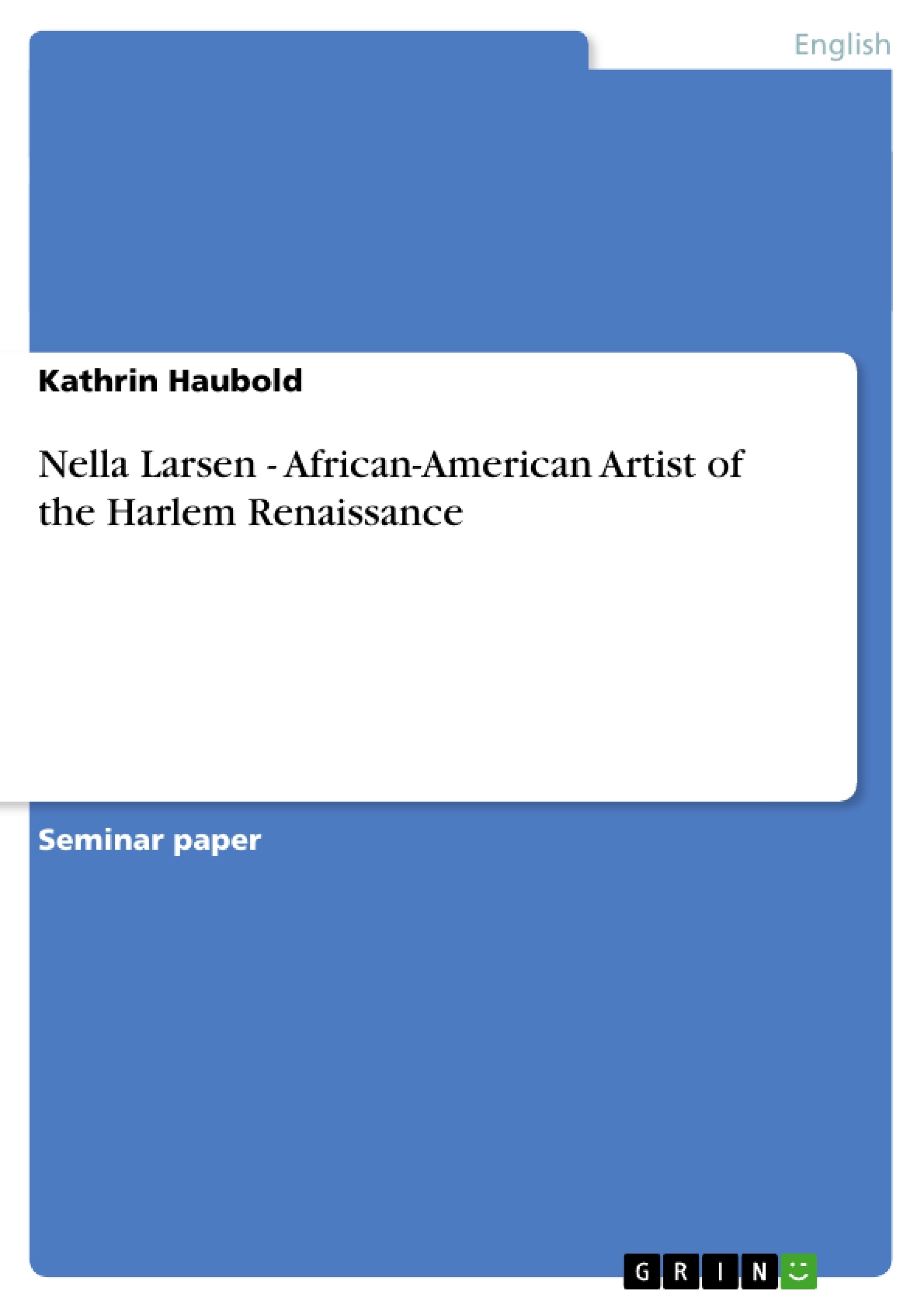This seminar paper will sketch some of the elements of the cultural “Zeitgeist” that shaped and was reflected in Nella Larsen’s writings. But it will concentrate on the novels that she left behind: Quicksand and Passing. An important topic Larsen is dealing with is race-identity. Larsen assimilates these themes in her two novels, not by representing the lower-class problem, but more by focusing on the life and problems of middle-class females. It is more the psychological than the sociological side she portrays. This paper demonstrates that race identity and race dualism reflects Larsen’s own life story. First I will give an introduction on the Harlem Renaissance era. Then I will focus on Nella Larsen’s life. I will examine her two novels Quicksand and Passing to find out how race identity and race dualism is assimilated in her novels.
Table of Contents
- 1. INTRODUCTION
- 2. NELLA LARSEN NOVELIST OF THE HARLEM RENAISSANCE
- 2.1. The Harlem Renaissance Era
- 2.2. The Black Women Writers of the Renaissance Period
- 2.3. Nella Larsen's Biography
- 3. QUICKSAND
- 3.1. Quicksand Plot Outline
- 3.2. Quicksand Themes
- 4. PASSING
- 4.1. Passing Plot Outline
- 4.2. Passing Themes
- 5. NELLA LARSEN AND THE TRAGIC MULATTO THEME
Objectives and Key Themes
This seminar paper aims to explore the cultural context of Nella Larsen's writing, specifically focusing on her novels Quicksand and Passing. It examines how the themes of race identity and dualism are reflected in Larsen's work, considering her own life experiences and the socio-political climate of the Harlem Renaissance.
- The Harlem Renaissance and its influence on Black literature
- Nella Larsen's life and its reflection in her novels
- The theme of race identity and its complexities
- The concept of racial dualism and its consequences
- The portrayal of middle-class Black women's experiences
Chapter Summaries
1. INTRODUCTION: This introductory chapter sets the stage by introducing Nella Larsen as a prominent novelist of the Harlem Renaissance. It highlights the significance of her two major novels, Quicksand and Passing, emphasizing their exploration of the "mulatto" theme and the challenges faced by those navigating racial boundaries in early 20th-century America. The chapter also briefly previews the paper's focus on Larsen's life and the cultural context of her work, foreshadowing an analysis of race identity and dualism within her novels.
2. NELLA LARSEN NOVELIST OF THE HARLEM RENAISSANCE: This chapter provides background information on Nella Larsen and the Harlem Renaissance. It discusses the social and political factors contributing to the flourishing of African-American art and literature during the 1920s and 30s, including the Great Migration, changing social attitudes and the rise of prominent figures in the movement. The subchapters delve into the specific context of Black women writers, placing Larsen within a broader literary landscape. The chapter concludes by introducing the central themes of race identity and dualism that Larsen explores, contextualizing them within her personal life and the wider historical moment.
Keywords
Nella Larsen, Harlem Renaissance, Quicksand, Passing, race identity, racial dualism, mulatto, Black women writers, African-American literature, 1920s, cultural context, psychological portrayal.
Frequently Asked Questions: Nella Larsen and the Harlem Renaissance
What is the purpose of this document?
This document provides a comprehensive preview of a seminar paper analyzing the works of Nella Larsen, a prominent novelist of the Harlem Renaissance. It includes a table of contents, objectives, key themes, chapter summaries, and keywords.
What novels by Nella Larsen are discussed?
The document focuses primarily on Nella Larsen's two major novels: Quicksand and Passing.
What are the key themes explored in the seminar paper?
The paper examines the themes of race identity, racial dualism, the complexities of navigating racial boundaries, and the experiences of middle-class Black women during the early 20th century. It also considers the influence of the Harlem Renaissance on Larsen's work.
What is the historical context of the paper?
The paper is situated within the historical context of the Harlem Renaissance, exploring the social, political, and cultural factors that shaped African-American art and literature during the 1920s and 1930s. The Great Migration and changing social attitudes are also considered.
What aspects of Nella Larsen's life are discussed?
The paper explores Nella Larsen's biography and how her personal life and experiences are reflected in her novels, particularly in relation to themes of race and identity.
What is the "mulatto" theme, and how is it relevant?
The "mulatto" theme, referring to individuals of mixed Black and white heritage, is a central focus. The paper analyzes how Larsen portrays the challenges and complexities faced by those navigating racial boundaries in early 20th-century America.
What is covered in each chapter?
Chapter 1 (Introduction): Introduces Nella Larsen and her novels, highlighting the "mulatto" theme and the challenges of racial boundaries. Chapter 2 (Nella Larsen, Novelist of the Harlem Renaissance): Provides background on Larsen and the Harlem Renaissance, including the context of Black women writers. Chapter 3 (Quicksand): Examines the plot and themes of Quicksand. Chapter 4 (Passing): Examines the plot and themes of Passing. Chapter 5 (Nella Larsen and the Tragic Mulatto Theme): Analyzes the "mulatto" theme in Larsen's work.
What are the keywords associated with this paper?
Keywords include: Nella Larsen, Harlem Renaissance, Quicksand, Passing, race identity, racial dualism, mulatto, Black women writers, African-American literature, 1920s, cultural context, psychological portrayal.
- Quote paper
- Kathrin Haubold (Author), 2002, Nella Larsen - African-American Artist of the Harlem Renaissance, Munich, GRIN Verlag, https://www.grin.com/document/16533




